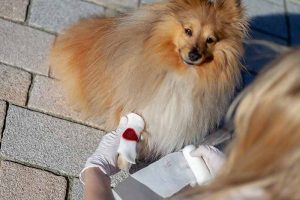Build Your Pet First Aid Kit
Build Your Pet First Aid Kit

Although we don’t like to think about it, emergencies can and do come up, especially when you own a pet. In those situations, it’s a great comfort to have a basic understanding of pet first aid as well as a well-stocked pet first aid kit.
If you’re prepared to respond to an accident, you can administer first aid to stabilize your pet until you can get to our office or the nearest emergency clinic. Remember that Parkside Animal Hospital is always here to help you navigate a pet emergency. You can call us with specific questions any time, but always come in right away if you’re worried about your pet.
Here, we’ll show you what you need in your pet first aid kit.
Pet First Aid Kit – The Basics
Every pet – from the most homebody cat to the most active and accident prone dog – needs a pet first aid kit handy. Here are the basic supplies we recommend to gather together for your kit.
Disinfectant cleanser – a simple soapy cleanser can help when there is a small wound, scrape or scratch that is too small to require veterinary care. It can also help clean debris out of deeper wounds until you can reach the veterinary hospital for medical attention.
Gauze sponges – in order to clean wounds or apply pressure to stop bleeding, you need something clean, and easy to carry around. Gauze works well for a myriad of cleaning needs. Keep it in a ziplock bag so that it stays clean.
Antibacterial ointment or spray – polysporin or an equivalent ointment or spray can alleviate some pain and also keep scratches, burns, and scrapes clean. Just make sure to get one with zero alcohol in it (alcohol stings!)
Artificial tears and eye wash – if there is debris in the eye, this constitutes a visit to the veterinary hospital. Washing out the eye gently with sterile eye wash before you head to the vet can alleviate some discomfort for your pet.
Stretchy, self adhesive bandaging – commonly known as vet wrap and cling gauze in a veterinary setting, a simple bandage set up is great for stopping bleeding and keeping wounds clean as you head to the veterinary hospital.
Newspaper and masking tape – this is a bit more advanced, but if your pet has a broken bone, you can use a newspaper roll and tape to act as a (very) temporary splint while you’re on your way. Immobilizing the bone can help make your pet a bit more comfortable on the car ride over to us.
Antihistamines – these are useful to carry around in the event your pet is stung by a bee or other insect. Swelling around the face is usually the first reaction to an allergen. Ask us for the correct dose for your individual dog.
Hydrogen peroxide – the cleaning solution can be used sparingly, and at the right dose this can also induce vomiting. It’s important to call us before administering hydrogen peroxide to cause vomiting, as it can sometimes make matters worse for your pet to do so. Having a small bottle of 3% in your pet first aid kit can be useful in some situations, however.
A bite not collar or elizabethan collar – a collar that prevents your pet from bothering a wound or a problem area is really useful if you are alone in transporting your pet to the veterinarian for treatment. You don’t want them to pull off a bandage during the ride in.
Other important items – a t-shirt and hair tie, Epsom salts, and a thermometer are other useful items that may be included in a pet first aid kit.
Things to Remember
Once you’ve built your kit, realize that even all these items may just be the basics of your pet first aid kit. Here are a few other useful tips:
- Make sure your kit is well labeled in case others need to access it to help your pet.
- Always include our phone number and that of the local emergency clinic on a card in your kit.
- Remember to take your pet first aid kit with you when you travel to your cottage or other location.
- Some people make several kits; one for home, one for the car, one for outdoor adventures, etc.
Everyone needs a first aid kit. But your kit may need different things based on your pet’s lifestyle and medical needs. This basic kit will give you what you need to get started, but ask us about your individual pet and what activities you enjoy together for more specifics. Now it’s your turn! What’s in your pet’s first aid kit?
